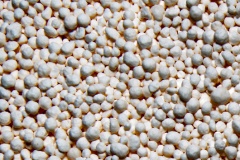Calcium Ammonium Nitrate
| Infobox on Calcium Ammonium Nitrate | |
|---|---|
| Example of Calcium Ammonium Nitrate |  |
| Facts | |
| Origin | |
| Stowage factor (in m3/t) | 0,9 m3/ft (bulk) |
| Humidity / moisture | 1% |
| Ventilation | |
| Risk factors | |
Calcium Ammonium Nitrate
Description /Application
Calcium ammonium nitrate, often abbreviated CAN, is a fertilizer which is a blend of about 20%-30% CaCO3 and 70%-80% Ammonium nitrate. It may also have a small percentage of calcium nitrate in it.
It contains nitrogen in both the ammoniacal and the nitric forms to provide plant nutrition during the whole growing period.
Calcium ammonium nitrate is a mixture (fuse) of ammonium nitrate and ground limestone. The product is physiologically neutral. It is manufactured in granular form (with size varied from 1 to 5 mm) and suitable for mixing with phosphate and potassium fertilizers. In comparison with ammonium nitrate CAN has better physical-chemical properties, less water-absorbing and caking as well as it can be stored in stacks.
Calcium ammonium nitrate can be used for all kinds of soil and for all types of agricultural crops as the main, presowing fertilizer and for top dressing. Under systematic use the fertilizer doesn’t acidify soil and supplies plants with calcium and magnesium. It is the most efficient in case of acidic and sodic soils and soils with light granulometric composition.











